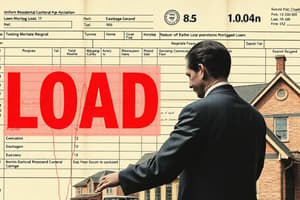Podcast
Questions and Answers
What does a fixed-rate mortgage ensure?
What does a fixed-rate mortgage ensure?
- Lower payments after the initial period
- Variable interest rates throughout the loan term
- Potential for negative amortization
- Constant interest rate throughout the loan term (correct)
Which type of loan is typically available without a down payment for veterans?
Which type of loan is typically available without a down payment for veterans?
- Adjustable-Rate Mortgages
- VA Loans (correct)
- FHA Loans
- USDA Loans
What is the first step in applying for a residential loan?
What is the first step in applying for a residential loan?
- Gather documentation
- Research lenders
- Complete formal loan application
- Asses financial situation (correct)
What does the pre-approval process involve?
What does the pre-approval process involve?
What should be included in the documentation for a loan application?
What should be included in the documentation for a loan application?
What is a characteristic of Adjustable-Rate Mortgages (ARMs)?
What is a characteristic of Adjustable-Rate Mortgages (ARMs)?
What financial aspect is crucial to determine before applying for a residential loan?
What financial aspect is crucial to determine before applying for a residential loan?
During the loan processing step, what does underwriting assess?
During the loan processing step, what does underwriting assess?
Why is it important to compare lenders before applying for a loan?
Why is it important to compare lenders before applying for a loan?
What is the typical range for a down payment on a home?
What is the typical range for a down payment on a home?
Which of the following is true regarding interest rates?
Which of the following is true regarding interest rates?
What is Private Mortgage Insurance (PMI) typically required for?
What is Private Mortgage Insurance (PMI) typically required for?
What is the purpose of an escrow account in a mortgage payment?
What is the purpose of an escrow account in a mortgage payment?
Which of the following is a common mistake when closing a loan?
Which of the following is a common mistake when closing a loan?
What should a borrower typically do before seeking a mortgage?
What should a borrower typically do before seeking a mortgage?
In choosing loan terms, what should be a key consideration?
In choosing loan terms, what should be a key consideration?
What is an important step to take before closing the loan?
What is an important step to take before closing the loan?
What typically affects the total cost of a loan over its lifetime?
What typically affects the total cost of a loan over its lifetime?
Flashcards are hidden until you start studying
Study Notes
Overview of Applying for a Residential Loan
- Definition: A residential loan is a type of financing used to purchase a home or refinance an existing mortgage.
Types of Residential Loans
-
Fixed-Rate Mortgages
- Interest rate remains constant throughout the loan term.
- Common terms: 15, 20, or 30 years.
-
Adjustable-Rate Mortgages (ARMs)
- Interest rate is fixed for an initial period, then adjusts periodically.
- Lower initial rates but variable payments after adjustment.
-
Government-Backed Loans
- FHA Loans: Insured by the Federal Housing Administration. Suitable for low-to-moderate income buyers.
- VA Loans: Available for veterans, service members, and some members of the National Guard and Reserves, with no down payment required.
- USDA Loans: For rural property buyers with low to moderate incomes, offering no down payment options.
Steps to Apply for a Residential Loan
-
Assess Financial Situation
- Review credit score and report.
- Calculate debt-to-income ratio.
- Determine budget for monthly payments and down payment.
-
Research Lenders
- Compare interest rates, terms, and fees from multiple lenders.
- Check lender reputation and reviews.
-
Gather Documentation
- Proof of income: Pay stubs, tax returns, or W-2 forms.
- Employment verification: Letter from employer or recent pay slips.
- Asset documentation: Bank statements, retirement accounts, other investments.
-
Pre-Approval Process
- Submit application to lender for pre-approval.
- Lender reviews financial information and determines loan amount eligibility.
- Pre-approval letter indicates loan amount you could secure, helping in home buying negotiations.
-
Loan Application
- Complete formal loan application with chosen lender.
- Provide all required documentation and information.
-
Loan Processing
- Lender reviews application, verifies information, and orders an appraisal.
- Underwriting process assesses risk and finalizes approval.
-
Closing the Loan
- Review closing disclosure detailing loan terms, fees, and costs.
- Sign closing documents, pay any necessary closing costs.
- Receive keys to the new property upon funding.
Key Considerations
- Down Payment: Typically ranges from 3% to 20% of the home purchase price.
- Interest Rates: Affects monthly payments and total loan cost; consider locking in rates.
- Loan Terms: Choose a term that fits long-term financial goals.
- Private Mortgage Insurance (PMI): Required if down payment is less than 20% on conventional loans.
- Escrow Account: May be set up for property taxes and insurance, included in monthly payment.
Common Mistakes to Avoid
- Not checking credit score beforehand.
- Failing to compare multiple lenders' offers.
- Underestimating additional costs (closing costs, taxes, insurance).
- Overlooking the importance of pre-approval.
- Ignoring the terms of the loan agreement.
Overview of Residential Loans
- A residential loan finances home purchases or refinances an existing mortgage.
Types of Residential Loans
-
Fixed-Rate Mortgages
- Constant interest rate throughout the loan term.
- Common terms last for 15, 20, or 30 years.
-
Adjustable-Rate Mortgages (ARMs)
- Fixed interest rate for an initial period, followed by adjustments.
- Offers lower initial rates but varying payments later.
-
Government-Backed Loans
- FHA Loans: Insured by the Federal Housing Administration, catering to low-to-moderate income buyers.
- VA Loans: Available for veterans and service members, requiring no down payment.
- USDA Loans: Designed for low to moderate income buyers in rural areas, often without down payment.
Steps to Apply for a Residential Loan
-
Assess Financial Situation
- Check credit score and report.
- Calculate debt-to-income ratio.
- Establish a budget for monthly payments and down payment.
-
Research Lenders
- Compare interest rates, terms, and fees.
- Verify lender reputation through reviews.
-
Gather Documentation
- Provide proof of income, such as pay stubs, tax returns, or W-2 forms.
- Include employment verification from an employer.
- Prepare asset documentation including bank statements and retirement accounts.
-
Pre-Approval Process
- Submit an application for pre-approval.
- Lender assesses financial information to determine loan eligibility.
- Pre-approval letters assist in home buying negotiations.
-
Loan Application
- Fill out a formal application with the selected lender.
- Supply all required documentation and information.
-
Loan Processing
- Lender reviews and verifies application details, and orders an appraisal.
- Underwriting assesses risk and final approval.
-
Closing the Loan
- Examine the closing disclosure outlining loan terms and costs.
- Sign closing documents and pay applicable closing costs.
- Receive property keys once the loan is funded.
Key Considerations
- Down Payment: Typically between 3% to 20% of the purchase price.
- Interest Rates: Impact monthly payments and overall cost; consider locking in rates.
- Loan Terms: Select terms aligning with long-term financial goals.
- Private Mortgage Insurance (PMI): Required if down payment is below 20% for conventional loans.
- Escrow Account: May be established for property taxes and insurance, included in monthly payments.
Common Mistakes to Avoid
- Neglecting to check credit score prior to applying.
- Not comparing offers from multiple lenders.
- Underestimating additional costs such as closing costs and insurance.
- Overlooking the significance of pre-approval.
- Ignoring specific terms and conditions in the loan agreement.
Studying That Suits You
Use AI to generate personalized quizzes and flashcards to suit your learning preferences.




